What If? (14 page)
Authors: Randall Munroe
Orbital Submarine
Q.
How long could a nuclear submarine last in orbit?
—Jason Lathbury
A.
Th
e submarine would be
fine, but the crew would be in trouble.
Th
e submarine wouldn’t burst. Submarine hulls are strong enough to withstand 50 to 80 atmospheres of external pressure from water, so they’d have no problem containing 1 atmosphere of internal pressure from air.
Th
e hull
would likely be airtight. Although watertight seals don’t necessarily hold back air, the fact that water can’t find a way through the hull under 50 atmospheres of pressure suggests that air won’t escape quickly.
Th
ere may be a few specialized one-way valves that would let air out, but in all likelihood, the submarine would remain sealed.
Th
e big problem the crew would face would be the obvious
one: air.
Nuclear submarines use electricity to extract oxygen from water. In space, there’s no water,
[
citation needed
]
so they wouldn’t be able to manufacture more air.
Th
ey carry enough oxygen in reserve to survive for a few days, at least, but eventually they’d be in trouble.
To stay warm, they could run their reactor, but they’d have to be very careful how
much
they ran it
—
because
the ocean is colder than space.
Technically, that’s not really true. Everyone knows that space is very cold.
Th
e reason spacecraft can overheat is that space isn’t as thermally conductive as water, so heat builds up more quickly in spacecraft than in boats.
But if you’re even
more
pedantic, it
is
true.
Th
e ocean is colder than space.
Interstellar space is very cold, but space near
the Sun
—
and near Earth
—
is actually incredibly hot!
Th
e reason it doesn’t seem that way is that in space, the definition of “temperature” breaks down a little bit. Space seems cold because it’s so
empty
.
Temperature is a measure of the average kinetic energy of a collection of particles. In space, individual molecules have a high average kinetic energy, but there are so few of them that they
don’t affect you.
When I was a kid, my dad had a machine shop in our basement, and I remember watching him use a metal grinder. Whenever metal touched the grinding wheel, sparks flew everywhere, showering his hands and clothes. I couldn’t understand why they didn’t hurt him
—
after all, the glowing sparks were several thousand degrees.
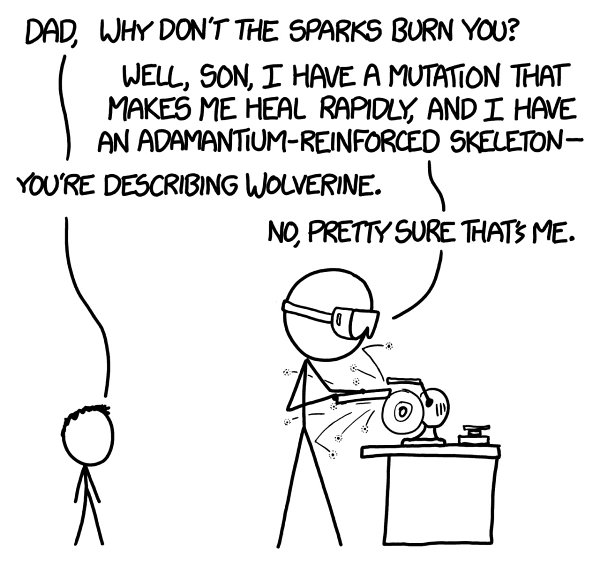
I later learned that the reason the sparks didn’t hurt him was that they were
tiny
; the heat they carried could be absorbed into the body without warming anything more than a tiny patch of skin.
Th
e hot molecules in space are like the sparks in my dad’s machine shop; they might be hot or cold, but they’re so small that touching them doesn’t change your temperature much.
1
Instead,
your heating and cooling is dominated by how much heat you produce and how quickly it pours out of you into the void.
Without a warm environment around you radiating heat back to you, you lose heat by radiation much faster than normal. But without air around you to carry heat from your surface, you also don’t lose much heat by convection.
2
For most human-carrying spacecraft, the latter effect
is more important; the big problem isn’t staying warm, it’s keeping cool.
A nuclear submarine is clearly able to maintain a livable temperature inside when the outer hull is cooled to 4°C by the ocean. However, if the submarine’s hull needed to hold this temperature while in space, it would lose heat at a rate of about 6 megawatts while in the shadow of the Earth.
Th
is is more than the 20
kilowatts supplied by the crew
—
and the few hundred kilowatts of apricity
3
when in direct sunlight
—
so they’d need to run the reactor just to stay warm.
4
To get out of orbit, a submarine would need to slow down enough that it hit the atmosphere. Without rockets, it has no way to do this.
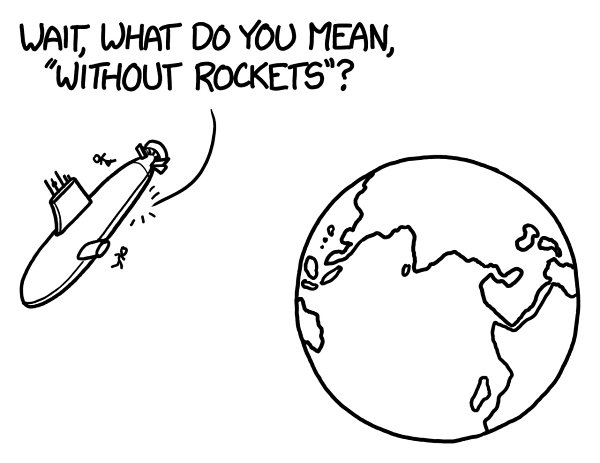
Okay
—
technically, a submarine
does
have rockets.
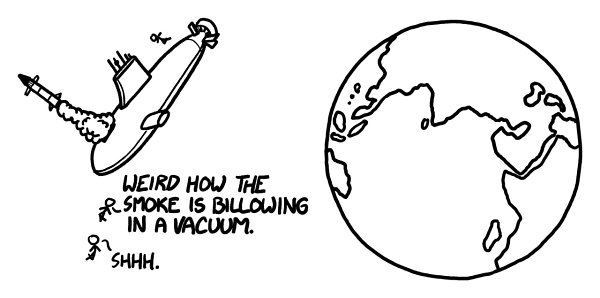
Unfortunately, the rockets are pointing the wrong way to give the submarine a push. Rockets are self-propelling, which means they have very little recoil. When a gun fires a bullet, it’s
pushing
the bullet up to speed. With a rocket, you just light it and let go. Launching missiles won’t propel a submarine forward.
But
not
launching them could.
If the ballistic missiles
carried by a modern nuclear submarine were taken from their tubes, turned around, and placed in the tubes backward, they could each change the submarine’s speed by about 4 meters per second.
A typical de-orbiting maneuver requires in the neighborhood of 100 m/s of delta-v (speed change), which means that the 24 Trident missiles carried by an
Ohio
-class submarine could be just enough to get
it out of orbit.
Now, because the submarine has no heat-dissipating ablative tiles, and because it’s not aerodynamically stable at hypersonic velocities, it would inevitably tumble and break up in the air.
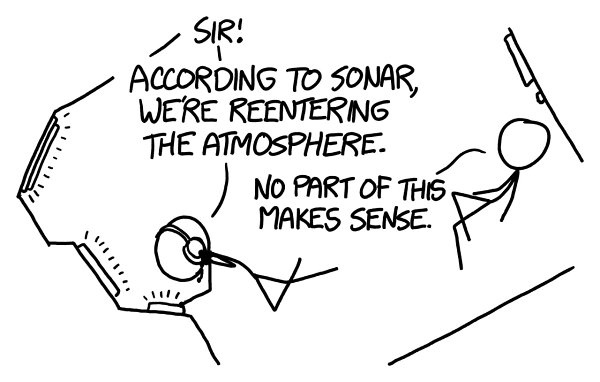
If you tucked yourself into the right crevice in the submarine
—
and were strapped into an acceleration couch
—
there’s a tiny, tiny,
tiny
chance that you could survive the rapid deceleration.
Th
en you’d need to jump out of the wreckage with a parachute before it hit the ground.
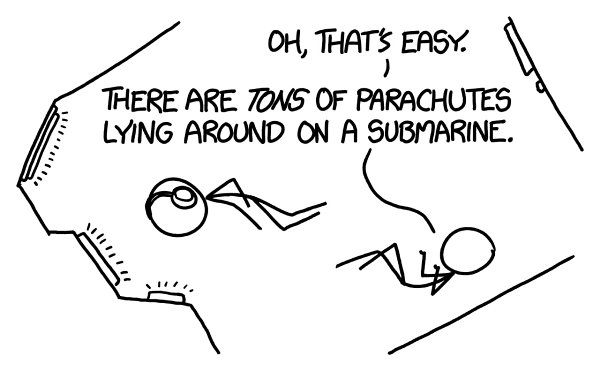
If you ever try this, and I suggest you don’t, I have one piece of advice that is absolutely critical:
Remember to disable the detonators on the missiles.

- 1
Th
is is why, even though matches and torches are about the same temperature, you see tough guys in movies extinguish matches by pinching them but never see them do the same with torches.
- 2
Or conduction.
- 3
Th
is is my single favorite word in the English language. It means the warmth of sunlight in winter.
- 4
When they moved into the Sun, the sub’s surface would warm, but they’d still be losing heat faster than they’d be gaining it.
Short-Answer Section
Q.
If my printer could literally print out money, would it have that big an effect on the world?
—Derek O’Brien
A.
You can fit four
bills on an 8.5"
×
11" sheet of paper.
If your printer can manage one page (front and back) of full-color high-quality printing per minute, that’s $200 million dollars a year.
Th
is is enough to make you very rich, but not
enough to put any kind of dent in the world economy. Since there are 7.8 billion $100 bills in circulation, and the lifetime of a $100 bill is about 90 months, that means there are about a billion produced each year. Your extra two million bills a year would barely be enough to notice.

Q.
What would happen if you set off a nuclear bomb in the eye of a hurricane? Would the storm cell be immediately vaporized?
—Rupert Bainbridge (and hundreds of others)
A.
Th
is question gets submitted
a lot.
It turns out the National Oceanic and Atmospheric Administration
—
the agency that runs the National Hurricane Center
—
gets it a lot, too. In fact, they’re asked about it so often
that they’ve published a response.
I recommend you read the whole thing,
1
but I think the last sentence of the first paragraph says it all:
“Needless to say, this is not a good idea.”
It makes me happy that an arm of the US government has, in some official capacity, issued an opinion on the subject of
firing nuclear missiles at hurricanes
.
Q.
If everyone put little turbine generators
on the downspouts of their houses and businesses, how much power would we generate? Would we ever generate enough power to offset the cost of the generators?
—Damien
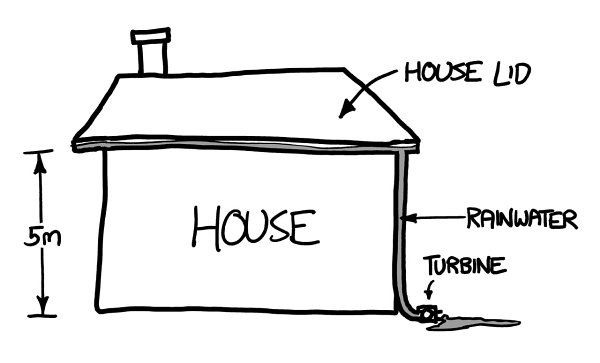
A.
A house in a
very rainy place, like the Alaska panhandle, might receive close to 4 meters of rain per year. Water turbines can be pretty efficient. If the house has a footprint of 1500 square feet and gutters 5 meters off the ground, it would generate an average of less than a watt of power from rainfall, and the maximum electricity savings would be:

Th
e rainiest hour on record as of 2014 occurred in 1947 in Holt, Missouri, where about 30 centimeters of rain fell in 42 minutes. For those 42 minutes, our hypothetical house could generate up to 800 watts of electricity, which might be enough to power everything inside it. For the rest of the year, it wouldn’t come close.
If the generator rig cost $100, residents of the rainiest
place in the US
—
Ketchikan, Alaska
—
could potentially offset the cost in under a century.
Q.
Using only pronounceable letter combinations, how long would names have to be to give each star in the universe a unique one-word name?
—Seamus Johnson
A.
Th
ere are about 300,000,000,000,000,000,000,000
stars in the universe. If you make a word pronounceable by alternating vowels and consonants (there
are better ways to make pronounceable words, but this will do for an approximation), then every pair of letters you add lets you name 105 times as many stars (21 consonants times 5 vowels). Since numbers have a similar information density
—100 possibilities per character
—this suggests the name will end up being about as long as the total number of stars:

Th
e stars are named Joe Biden.
I like doing math that involves measuring the lengths of numbers written out on the page (which is really just a way of loosely estimating log
10
x
). It works, but it feels so
wrong.
Q.
I bike to class sometimes. It’s annoying biking in the wintertime, because it’s so cold. How fast would I have to bike for my skin to warm up the way a spacecraft
heats up during reentry?
—David Nai
A.
Reentering spacecraft heat up
because they’re compressing the air in front of them (not, as is commonly believed, because of air friction).
To increase the temperature of the air layer in front of your body by 20 degrees Celsius (enough to go from freezing to room temperature), you would need to be biking at 200 meters per second.
Th
e fastest
human-powered vehicles at sea levels are recumbent bicycles enclosed in streamlined aerodynamic shells.
Th
ese vehicles have an upper speed limit near 40 m/s
—
the speed at which the human can just barely produce enough thrust to balance the drag force from the air.
Since drag increases with the square of the speed, this limit would be pretty hard to push any further. Biking at 200 m/s would
require at least 25 times the power output needed to go 40 m/s.
At those speeds, you don’t really have to worry about the heating from the air
—
a quick back-of-the-envelope calculation suggests that if your body were doing that much work, your core temperature would reach fatal levels in a matter of seconds.
Q.
How much physical space does the Internet take up?
—Max L
A.
Th
ere are a
lot
of ways to estimate the amount of information stored on the Internet, but we can put an interesting upper bound on the number just by looking at how much storage space we (as a species) have purchased.
Th
e storage industry produces in the neighborhood of 650 million hard drives per year. If most of them are 3.5-inch drives, that’s 8 liters (2 gallons) of hard drive per second.
Th
is
means the last few years of hard-drive production
—
which, thanks to increasing size, represents the majority of global storage capacity
—
would just about fill an oil tanker. So, by that measure, the Internet is smaller than an oil tanker.
Q.
What if you strapped C4 to a boomerang? Could this be an effective weapon, or would it be as stupid as it sounds?
—Chad Macziewski
A.
Aerodynamics aside,
I’m curious
what tactical advantage you’re expecting to gain by having the high explosive fly back at you if it misses the target.

- 1
Search for “Why don’t we try to destroy tropical cyclones by nuking them?” by Chris Landsea.